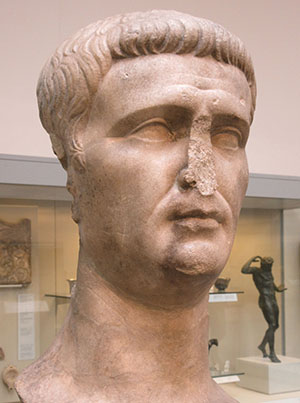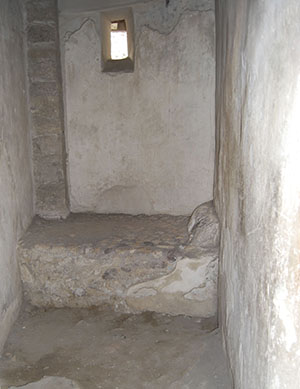The question as to why parents might expose a new-born child has perplexed people living in the 20th and 21st centuries. It seems so alien that a civilization as complexed as Rome might also contain such an aspect. The evidence is far from straight-forward (as you will see from the links), but we can piece together some of the reasoning of people 2000 years ago. In this blog, we set out the evidence for you, so that you may consider how the Romans may have thought about this practice. Read the blog and consider the choices facing Roman parents and what this practice indicates about Roman culture.
Exposing the newborn infant
When the decision was made not to rear an infant, the child would be left at a location to await its fate. Places within the city became known as sites for the exposure of unwanted children. Juvenal identifies some for us as the lactoria columna or the spurci lacus (VI.603). Abandoning an infant at one of these places, increased its chances of survival because anyone looking to ‘adopt’ or rear a child would have sought out newborn children at these places. In contrast, the infant left in a more isolated place outside the city was left to die rather than to be found.
 Portrait of the Emperor Claudius, who had the daughter of his wife Urgulanilla ‘cast out naked’. British Museum. Image: Paula Lock.
Portrait of the Emperor Claudius, who had the daughter of his wife Urgulanilla ‘cast out naked’. British Museum. Image: Paula Lock.
Exposed infants were left clothed, but this was not always the case. Suetonius mentions that the Emperor Claudius insisted the daughter of his wife Urgulanilla by a freed slave be ‘cast out naked’ (Suet., Claud. 27) reducing its chances of survival. This case shows the intention to kill the infant, in contrast to the abandonment of children in the hope of others caring for them.
We know that sometimes parents left tokens with their infant in the hope that these items may be recognized in the future to identify the abandoned child as a family member. These might include items such as rattles and crepundia (definition here). This is a feature of the novel Daphnis and Chloe, written at the time of the Roman Empire by the Greek novelist Longus. You can read the story here.
Excercise: why might the exposure of an infant not result in their death?
How could an exposed or abandoned child be recognised by its parents later in life?
 Altar showing Romulus and Remus — perhaps two of the most famous foundlings — being nursed by the she-wolf. Palazzo Massimo alle Terme, Rome. Image: Paula Lock
Altar showing Romulus and Remus — perhaps two of the most famous foundlings — being nursed by the she-wolf. Palazzo Massimo alle Terme, Rome. Image: Paula Lock
Exercise: examine each of the following 5 reasons for exposure given below and consider how the Romans explained that decision. If you lived in Rome: was there an ethically correct reason to expose a child?
Reason 1: Economic
Perhaps the most common reason found to explain the exposure of children is an economic one. For a poor family, the arrival of an extra mouth to feed would result only in diminished shares for everyone and greater hardship. However, according to the stoic philosopher Musonius Rufus, even the rich would expose their children. Read about Musonius’ thoughts on exposure here.
Reason 2: Birth defects
Nearly 1 in 30 of modern births result in children with some form of birth defect. Modern medicine has become an effective counter to many of these. However, without it, bringing up a child with a major medical problem (such as hydrocephalus) would have been challenging for parent and child. Soranus gives an extensive list of criteria to judge if an infant is healthy enough to rear (II.10). For example, the baby must cry vigorously, its limbs and organs must be sound, its orifices must all open and the movement of each part of the body must not be sluggish or weak.
Reason 3: Illegitimacy
Questionable parentage is another factor that could lead to abandonment. As noted earlier, Claudius ordered the exposure of an illegitimate child and — according to Suetonius — Augustus also forbade the rearing of an illegitimate child born to Julia, his grand-daughter (Aug. 65). The Roman poet Ovid writes of the exposure of a baby born to Canace. Canace committed incest with her brother and her outraged father ordered the child to be thrown to the dogs and birds. You can read the passage here.
Reason 4: Evil omens
According to Suetonius, another reason for exposure was evil omens. For example, he claims that the out-pouring of grief at the death of the Emperor Germanics in AD 19 resulted in parents exposing their new-born children (Suet., Cal. 5). They also stoned the temples, overturned altars and threw their household gods into the street. This seems a fairly rare occurrence.
Reason 5: Gender
It is often suggested that more girls were exposed than boys. This is illustrated in a letter from a husband to his wife, telling her that if she gives birth to a boy to let it live, if it is a girl, to expose it (see the link here). The same scenario can be seen in drama, for example in Terence’s play Heautontimorumenos. Sostrata is given strict orders by her husband Chremes that she is not to rear her child if it is a girl (Haut. 626). You can read the play here. We have no idea how many people faced this choice or used this logic to decide whether they should rear a child.
 A room in the lupanar (brothel) at Pompeii. Image: Paula Lock
A room in the lupanar (brothel) at Pompeii. Image: Paula Lock
What became of the exposed infants who were found and taken up?
Of those foundlings who survived their early childhood, many would have become slaves. Indeed, this was probably one of the reasons that the practice of exposure was accepted — it fueled the supply of free labour. The Romans also had a fear that the exposure of a child might lead to a father having sex with his own daughter. The Christian apologist Justin explains the nature of this danger, if the child was brought up to become a prostitute (Chapter 27. Guilt of exposing children).
Exercise: how different were the choices facing Roman parents from those of parents in the 21st century?
Further reading
Dixon, Suzanne. The Roman Family. Ancient Society and History. Baltimore; London: Johns Hopkins University Press, 1992.
Harris, W. V. Child-Exposure in the Roman Empire, The Journal of Roman Studies, Vol. 84 (1994), pp. 1-22 Published by: Society for the Promotion of Roman Studies.
Harlow, Mary, and Ray Laurence. Growing up and Growing Old in Ancient Rome: A Life Course Approach. London: Routledge, 2002.
Rawson, Beryl. Children and Childhood in Roman Italy. Oxford: Oxford University Press, 2003.